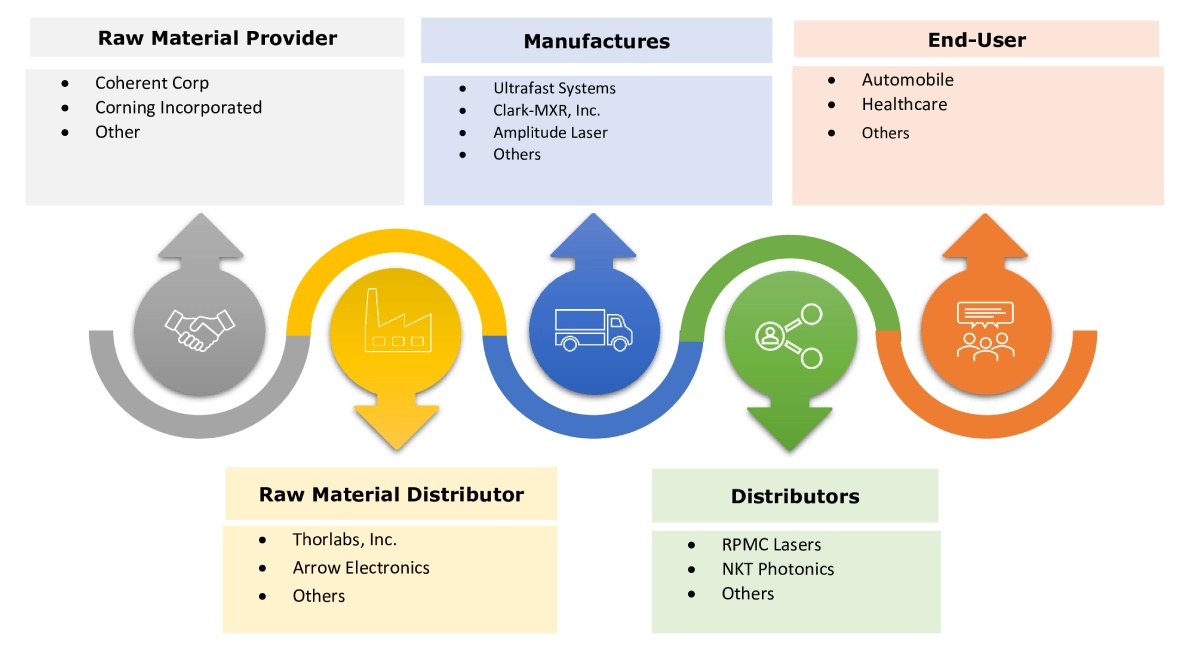- Summary
- Table Of Content
- Methodology
Ultrafast Laser Market Size:
Ultrafast Laser Market size is estimated to reach over USD 6,451.94 Million by 2031 from a value of USD 1,994.29 Million in 2023 and is projected to grow by USD 2,274.01 Million in 2024, growing at a CAGR of 15.8% from 2024 to 2031
Ultrafast Laser Market Scope & Overview:
Ultrafast lasers are devices producing extremely short pulses of light for direct investigation and manipulation of atoms and electrons. Moreover, the laser system is majorly used for various processing methods such as cutting, drilling, ablation, and structuring for a wide range of materials. The benefits include efficient electricity consumption, minimal maintenance, high precision, high accuracy, compact design, and others. Further, the rising demand in material processing is propelling the ultrafast laser market share. Furthermore, the high precision and accuracy are driving the adoption in various end-use industries including automotive, consumer electronics, healthcare, and more.
Ultrafast Laser Market Dynamics - (DRO) :
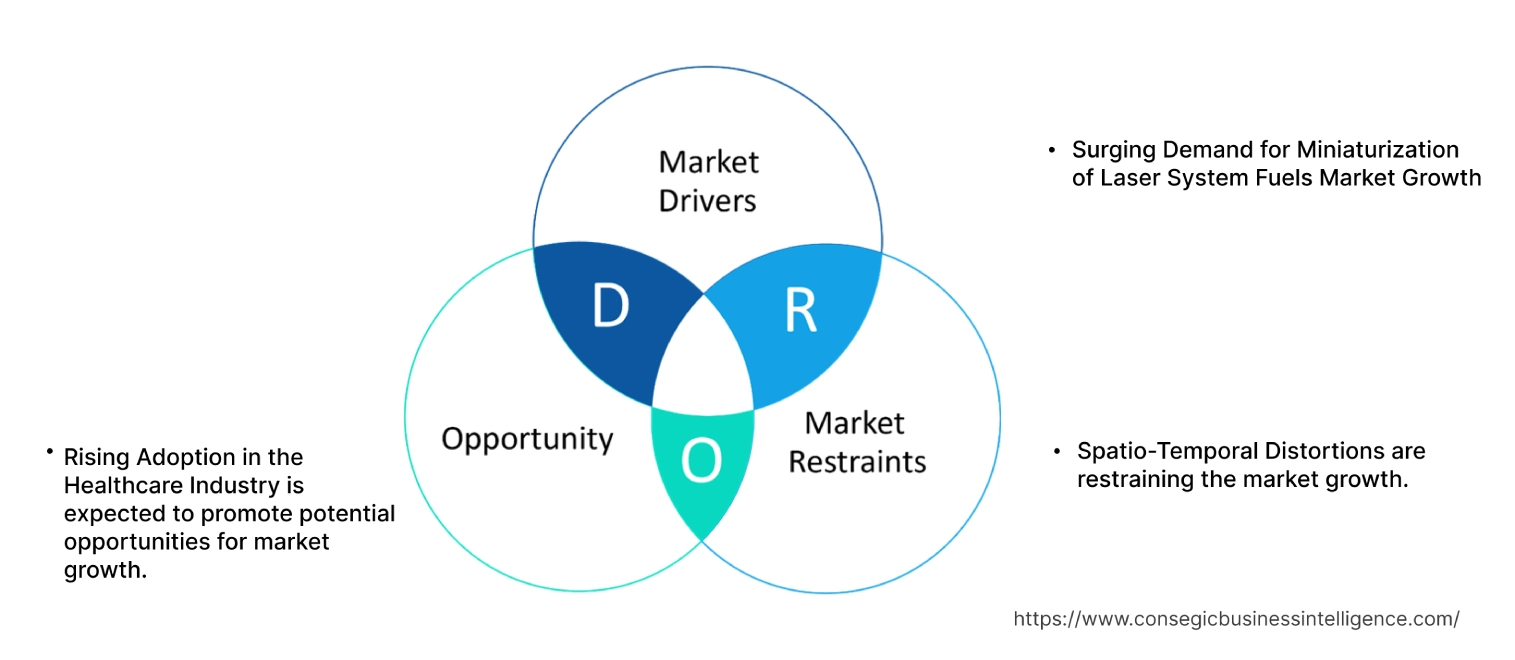
Key Drivers:
Surging Demand for Miniaturization of Laser System Fuels Market Growth
The rising demand for compact laser systems with ultrashort high-energy pulses is driving the ultrafast laser market growth. The compact design of the laser systems attracts end users requiring ultrafast beams in a compact and easy-to-setup system. Moreover, applications such as imaging and life science benefit from compact laser systems fueling the expansion of the market.
- For instance, in June 2023, Edmund Optics partnered with Chromacity for the launch of Chromacity 1040 Ultrafast Laser which is a compact laser ideal for various applications including multi-photon microscopy, spectroscopy research, and others.
Thus, the ability to produce ultrashort high-energy pulses and the rising need for imaging and life science applications are driving the miniaturization of the ultrafast laser market.
Key Restraints :
Spatio-Temporal Distortions are restraining the market growth.
The intensity and phase vary in space and equivalently vary in time causing spaio-temporal distortions in the laser system is hindering the ultrafast laser market expansion. Also, the issue distorts the laser focus which hinders the adoption of laser systems. Moreover, the spatio-temporal distortion affects the ability to achieve precision and high-quality material ablation hindering the market demand.
Thus, the distortion in laser with space or time hampering the precision and material ablation is restraining the ultrafast laser market expansion.
Future Opportunities :
Rising Adoption in the Healthcare Industry is expected to promote potential opportunities for market growth.
The laser is increasingly used in various medical applications such as eye surgery procedures, precision micromachining of critical materials, and others. Adoption is increasing due to the ease of integration and reliability which is driving the ultrafast laser market opportunity. Further, the rising need for high-quality precision, speed, and accuracy in various medical device manufacturing is propelling the need for laser systems. Furthermore, benefits include reduced heat-affected zones, premium UDI marks, precise cut width, and more.
- For instance, in July 2024, ViaLase, Inc. achieved CE Mark for ViaLase Laser which is a combination of femtosecond laser and micron-level image guidance for glaucoma treatment.
Thus, the rising need for high-quality precision, speed, and accuracy is propelling the ultrafast laser market opportunity.
Ultrafast Laser Market Segmental Analysis :
By Type:
Based on the type, the market is segmented into titanium–sapphire lasers, fiber lasers, dye lasers, mode-locked lasers, and others.
Trends in the technology:
- The trend towards compact, powerful, and cost-effective solutions is propelling the mode-locked lasers.
- The revolutionizing medical imaging and advancing optical communications is propelling the growth of titanium–sapphire lasers.
The fiber laser accounted for the largest revenue share of 29.83% in the year 2023.
- The fiber lasers are majorly used in applications such as scientific research, medical technology, and materials microprocessing driving the growth of fiber lasers.
- They offer a range of benefits including ultra-short pulse, high peak power, high repetition rate, and ease of use, among others.
- Moreover, they are utilized in supercontinuum generation, ultrafast spectroscopy, multiphoton imaging, and other industrial applications that require ultrafast fiber laser systems.
- For instance, in November 2023, RPMC Lasers Inc. partnered with fluence technology for the distribution of RPMC ultrafast fiber laser portfolio and other devices.
- Thus, as per the analysis, the rising adoption in scientific research and medical technology is driving the fiber-based ultrafast laser market trends.
The mode-lock laser is anticipated to register the fastest CAGR during the forecast period.
- Mode-locking is a process of generating ultra-short pulses in picoseconds or femtoseconds. Additionally, the mode-lock laser is majorly used in corneal eye surgery and femtosecond laser micromachining due to its elevated level of accuracy.
- Moreover, the benefits of mode lock laser include high speed, high pulse-peak intensity, and broad-spectrum coverage for applications such as making or breaking molecular bonds during chemical reactions boosting the ultrafast laser market growth.
- For instance, in November 2023, the Photonics team developed ultrafast mode-lock lasers. The system features high performance and accuracy with a compact design that fits on a fingertip.
- Therefore, the aforementioned benefits and rising adoption in various applications are anticipated to boost the growth of the market during the forecast period.
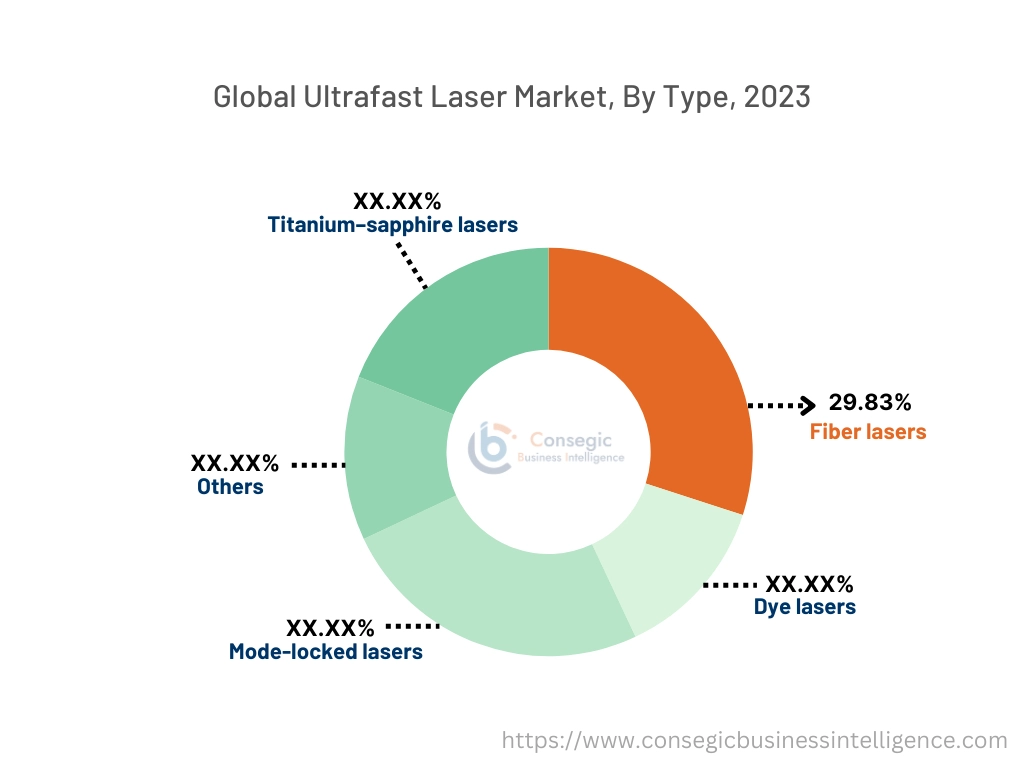
By Pulse:
Based on the pulse, the market is bifurcated into picosecond and femtosecond.
Trends in the Pulse:
- The rising adoption of picosecond laser in dermatology for facial photoaging and enlarged facial pores among others due to reduced thermal diffusion.
- The rising adoption of femtosecond laser in the LASIK or cataract surgery.
The femtosecond accounted for the largest revenue share in the year 2023 and is anticipated to register the fastest CAGR during the forecast period.
- The lasers emit optical pulses in femtoseconds which is 10−15 seconds and the technique used is mode-locking.
- Moreover, the rising adoption of material processing due to reduced thermal damage of materials is driving the market.
- Additionally, they offer a range of benefits including high peak power, high accuracy, and precision, among others.
- Further, they are utilized in biology or chemistry, material processing, and other industrial applications requiring laser systems.
- For instance, in October 2024, TeraXion launched VINCI-1064, which is a femtosecond fiber laser. The laser system is ideal for applications such as multiphoton microscopy and two-photon polymerization. Additionally, the features include high peak power, short pulse duration, low cost, and others.
- Thus, as per the analysis, the rising adoption in material processing is driving the femtosecond ultrafast laser market trends.
By End-User:
Based on the end-user, the market is segmented into research, consumer electronics, healthcare, automotive, aerospace and defense, and others.
Trends in the End-users:
- The trend towards the development of exhaust gas sensors, which are mostly used in the automotive sector with the help of laser systems, is driving the market trend.
- The laser system is increasingly adopted in the manufacturing of aerospace components due to the integration of sensors for improving the lifespan of metal.
The research accounted for the largest revenue share in the year 2023.
- The laser systems help researchers with the investigation of a wide range of medical, chemical, and biological phenomena. Also, in research and development high intensity and short duration laser is required which in turn drives the ultrafast laser market demand.
- Further, the rising need for understanding electronic structure and quantum mechanics is propelling researchers to adopt and advance the market.
- For instance, in August 2020, according to the Ministry of Science & Technology India, scientists developed an eco-friendly that protects biomedical and other applications. The self-cleaning surface utilizes an ultrafast laser for the fabrication of the surface which eliminates the need for coating or surface treatment.
- Thus, as per the analysis, the rising adoption in research and investigation is driving the ultrafast laser market share.
Healthcare is anticipated to register the fastest CAGR during the forecast period.
- The laser system plays a key role in various healthcare industry applications which includes treatment of wet macular degeneration, cataract surgery as well as correction of corneal astigmatism, among others.
- Further, the rising adoption in the surgical application of laser due to its non-linear interaction with the cell tissues and low heat output is boosting the ultrafast laser market demand in the healthcare sector.
- For instance, in January 2024, The INRS team partnered with McGill University Health Centre for the demonstration to show radiation treatment of cancer with the help of ultrafast laser technology.
- Thus, according to the ultrafast laser market analysis, the rising adoption in surgical applications is anticipated to boost the evolution of the market during the forecast period.
Regional Analysis:
The regions covered are North America, Europe, Asia Pacific, the Middle East and Africa, and Latin America.
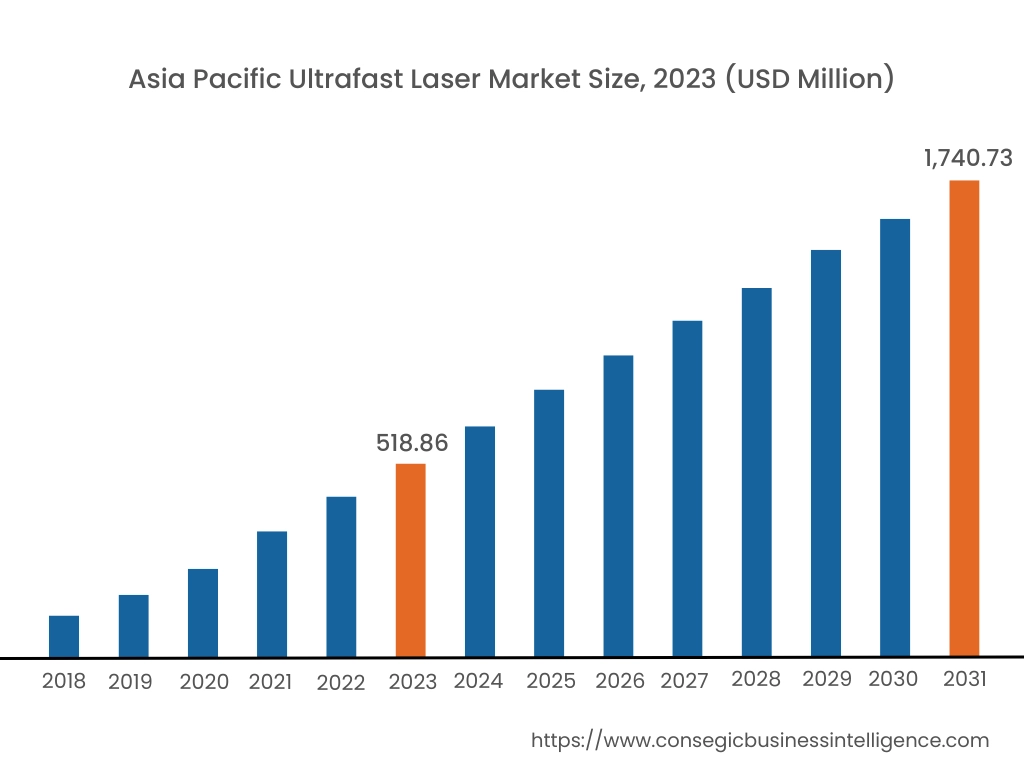
Asia Pacific region was valued at USD 518.86 Million in 2023. Moreover, it is projected to grow by USD 593.46 Million in 2024 and reach over USD 1,740.73 Million by 2031. Out of this, China accounted for the maximum revenue share of 29.5%. As per the ultrafast laser market analysis, to growing need in medical materials processing, optoelectronic semiconductors manufacturing and others is the primary factor fueling the ultrafast laser market size. Additionally, the rising need for femtosecond lasers is driving the market. Moreover, technological advancement such as the development of engineering thermoplastics that withstand harsh weather conditions integrated with sensors is propelling the need for laser direct writing technique, driving the market evolution.
- For instance, in September 2023, the Ministry of Economic Affairs, Taiwan collaborated with Lithuania for the development of an ultrafast laser technology research & innovation center in Tainan.
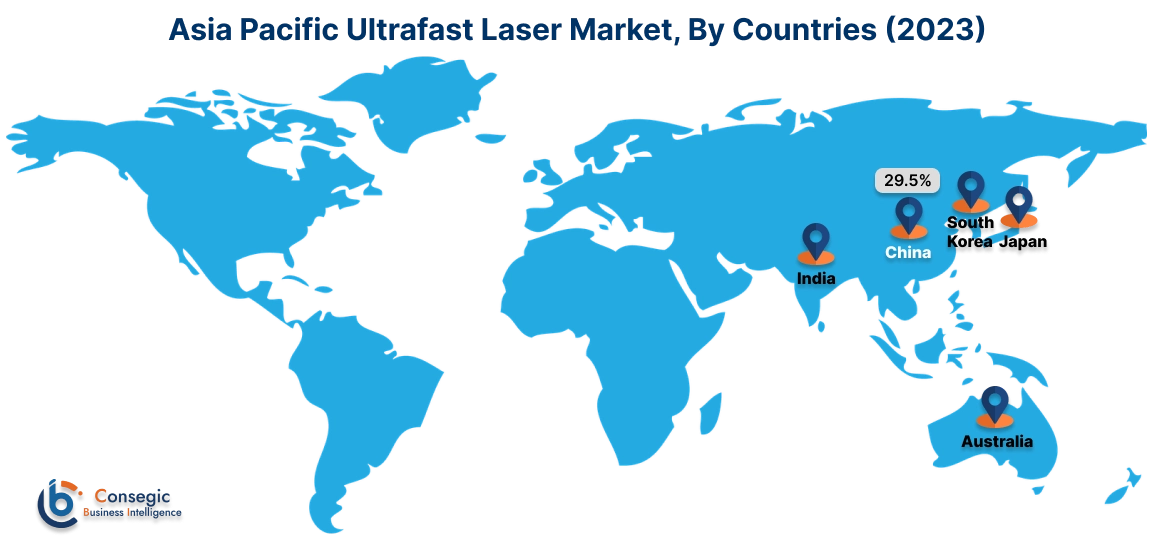
North America is estimated to reach over USD 2,277.54 Million by 2031 from a value of USD 700.15 Million in 2023 and is projected to grow by USD 798.71 Million in 2024. Moreover, the rising need for microelectronics, medical devices, and life science is boosting the need for the ultrafast laser industry. Additionally, continuous research and development in the field of research and science are propelling the evolution of the ultrafast laser market in the North American region.
- For instance, in November 2023, The University of Nebraska–Lincoln developed an ultrafast laser for surface modification in the United States. The femtosecond laser surface processing is ideal for applications in space, defense, medicine, and more.
The regional trends analysis depicts that the increasing focus on light and compact laser systems in Europe is driving the ultrafast laser market size. Additionally, the primary factor driving the market in the Middle East and African region is increasing collaboration between institutions and academia as well as government initiative and funding. Further, the rising demand for fiber lasers is paving the way for the progress of laser processing market trends in the Latin America region.
Top Key Players & Market Share Insights:
The global ultrafast laser market is highly competitive with major players providing lasers to the national and international markets. Key players are adopting several strategies in research and development (R&D), product innovation, and end-user launches to hold a strong position in the ultrafast laser industry. Key players in the ultrafast laser market include-
- Thorlabs, Inc. (USA)
- Lumentum Operations LLP (USA)
- Coherent Corp. (USA)
- Edmund Optics India Private Limited (Asia Pacific)
- Novanta Photonics (USA)
- IPG Photonics Corporation (USA)
- Newport Corporation (USA)
- Ultrafast Systems (USA)
- Clark-MXR, Inc. (USA)
- Amplitude Laser (UK)
Recent Industry Developments :
Product launches:
- In September 2024, SuperLight Photonics launched SLP-0280 which is an ultrafast laser with features such as 25 femtosecond pulse, ultra-stable, and small form factor.
- In June 2023, MKS Instruments, Inc. launched the Spectra-Physics IceFyre FS IR200 laser, which is a femtosecond laser. The laser offers numerous benefits such as high performance and flexibility.
Mergers & Acquisitions
- In July 2024, TroGroup acquired Luxinar, which is a manufacturer of laser systems in the UK. The acquisition aims to enhance technological leadership in the field of laser sources.
- In May 2024, Hamamatsu Photonics K.K. acquired NKT Photonics, which is a leading supplier of high-performance fiber laser and other technology. The acquisition aims to accelerate the business in the fields of semiconductor, quantum, and medical.
Funding
- In April 2024, ViaLase, Inc., achieved Series C funding of USD 40 million for the advancement of Femtosecond Laser for the Treatment of Glaucoma.
Ultrafast Laser Market Report Insights :
| Report Attributes | Report Details |
| Study Timeline | 2018-2031 |
| Market Size in 2031 | USD 6,451.94 Million |
| CAGR (2024-2031) | 15.8% |
| By Type |
|
| By Pulse |
|
| By End-User |
|
| By Region |
|
| Key Players |
|
| North America | U.S. Canada Mexico |
| Europe | U.K. Germany France Spain Italy Russia Benelux Rest of Europe |
| APAC | China South Korea Japan India Australia ASEAN Rest of Asia-Pacific |
| Middle East and Africa | GCC Turkey South Africa Rest of MEA |
| LATAM | Brazil Argentina Chile Rest of LATAM |
| Report Coverage |
|
Key Questions Answered in the Report
How big is the ultrafast laser market? +
The Ultrafast Laser Market size is estimated to reach over USD 6,451.94 Million by 2031 from a value of USD 1,994.29 Million in 2023 and is projected to grow by USD 2,274.01 Million in 2024, growing at a CAGR of 15.8% from 2024 to 2031.
What specific segmentation details are covered in the ultrafast laser report? +
The ultrafast laser report includes specific segmentation details for type, pulse, end-use, and regions.
Which is the fastest segment anticipated to impact the market growth? +
In the ultrafast laser market, the femtosecond is the fastest-growing segment during the forecast period due to rising adoption in material processing due to reduced thermal damage of materials.
Who are the major players in the ultrafast laser market? +
The key participants in the ultrafast laser market are Thorlabs, Inc. (USA), Lumentum Operations LLP (USA), Coherent Corp. (USA), Edmund Optics India Private Limited (Asia Pacific), Novanta Photonics (USA), IPG Photonics Corporation (USA), Newport Corporation (USA), Ultrafast Systems (USA), Clark-MXR, Inc. (USA), Amplitude Laser (UK) and others.
What are the key trends in the ultrafast laser Market? +
The ultrafast laser market is being shaped by several key trends including the development of exhaust gas sensors with the help of ultrafast laser and increasingly adopted in the manufacturing of aerospace components due to the integration of sensors for improving the lifespan of metal and other as well as rising adoption of picosecond laser in dermatology for facial photoaging and enlarged facial pores among others due to reduced thermal diffusion are the key trends driving the market.

